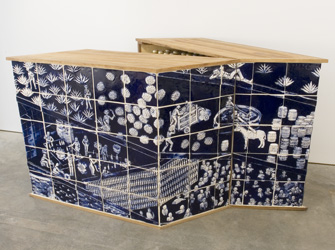Eduardo Sarabia, Babylon Bar, 2006.
Born 1976 in Los Angeles, California; lives in Los Angeles, California, Guadalajara, Mexico, and Berlin, Germany
As the creator of fake evidence for his staged, semifictional events, Eduardo Sarabia places himself within a tradition of contemporary artists who mine culture for their performance-based satire. In the postmodern, mixed-media mode of Cameron Jamie, Sarabia invents scenarios that he participates in and creates documentation for, commemorating the event’s unfolding. Handcrafted ceramic objects, drawings, paintings, photographs, and sculptures transform the exhibition space into a site for storytelling where viewers must suspend disbelief to enter the artist’s fantastic, romanticized realm. These theatrical situations revolve around Sarabia’s Latino heritage, which he both honors and mocks through his investigation of Mexican cultural clichés about drug smuggling, banditry, and the import/export of tawdry contraband.
Sarabia’s love of Mexican folklore is implicit in the creation of his own personalized mythologies. At New York’s I-20 Gallery in 2003, he presented documentation from a real-life expedition he launched outside Mazatlán to hunt for Pancho Villa’s gold, following in his grandfather’s footsteps. In a 2006 show at I-20 Gallery, Sarabia further pushed his interest in evidence and its exhibition by removing the performative aspect of his project, leaving only the materials confiscated at the fictional bust of an international ceramics smuggling ring. A large chromogenic print, Puerto Vallarta (2004), reveals Sarabia dressed as a smuggler deboarding a private plane with his girlfriend, pet tiger, and crates that, innocuously labeled “avocados,” “karaoke system,” and “bananas,” imply a less innocent cargo. An installation titled A Thin Line between Love and Hate (2005) juxtaposed shipping boxes screenprinted with benign phrases and pictures describing the produce ostensibly inside (“Maizena,” “Producto de Colima”) and the containers’ “real” contents—blue-and-white Chinesestyled vases bearing imagery of pinup girls, marijuana leaves, rifles, and skulls. Replacing site-specific engagement, the installation implied that reality is determined by its physical artifacts.
Through the fall of 2006 and the following spring and summer, Sarabia engaged an entirely different “reality” by hosting Salon Aleman, a sporadically open bar at local seminar/residency program unitednationsplaza in Berlin. This series of parties, at which patrons drank the artist’s Sarabia tequila, played on the stereotype of Latinos as cantina dwellers while reminding attendees that third-world poverty, exemplified by rural agave farming and the tequila it produces, is exacerbated by the first-world market economy. By encouraging an “unproductive” endeavor as he promoted his own product, he also more eloquently questioned art’s market value. Sarabia’s narrative concepts, defined by the tangible and intangible, contain a hearty dose of humor and absurdity that both lighten his political messages and reinforce the importance of understanding the physical and human consequences of economic forces. TRINIE DALTON
Eduardo Sarabia, Babylon Bar, 2006. Handmade ceramic tiles and rosewood, 48 x 48 x 48 in. (121.9 x 121.9 x 121.9 cm). Collection of the artist; courtesy I-20, New York

























